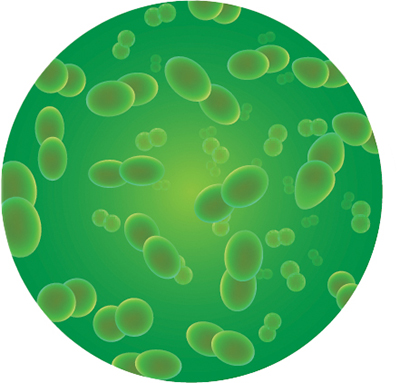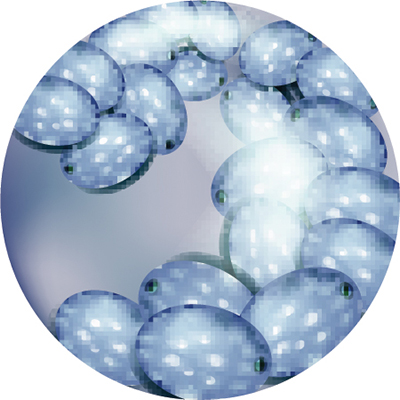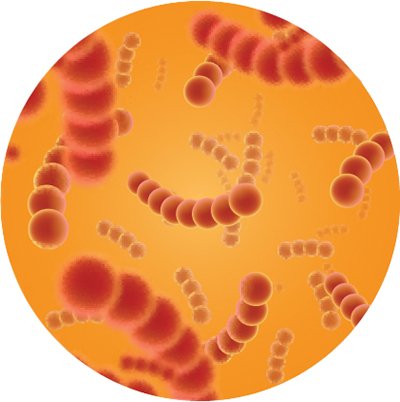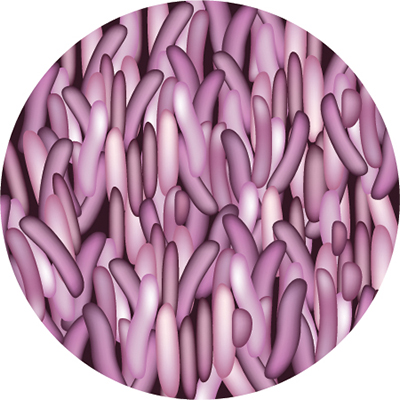Springtime Gut Reset: Should I Be Taking Probiotics?
Springtime signals a fresh start. Longer days and renewed motivation mean revisiting New Year’s resolutions and focusing more on health.
Let us talk about the microbiome. Thirty-eight trillion (3.8 × 10¹³) bacterial cells live on our skin and within our gut, successfully outnumbering the thirty trillion (3.8 × 10¹³) cells that make up the average human body.[1] The microbes, otherwise known as bacteria, that live within the gut affect all of the biochemical pathways that work to regulate bowel function, immunity, metabolism, mental health, cognition and overall wellbeing.[2], [3]
What Is a Gut Reset?
A gut reset aims to restore the balance of the microbiome, thereby improving overall health and wellbeing. Let us be clear: this is not a detox, or a gut-bug kill protocol. It is important to note that people with severe gastrointestinal disturbances may require more than a simple reset to resolve symptoms and address the root cause of their disease. However, most of the population can benefit from the incorporation of the following habits.[4]
Some protocols may change the order and add specifics, but all gut resets emphasize the same core components:
- Eliminate Obstacles: Remove the overly processed foods! Lactose intolerant? Gluten intolerant? Coffee gives you the “runs”? These foods wreak havoc on the mucosal gut lining that is protecting your gut and housing your microbiome.
- Increase Hydration: Water lubricates the gut lining to make sure cells communicate properly.
- Increase Movement: Physically stimulate gut activity.
- Regulate Sleep: A bedtime that is 3 hours after your last meal will support your blood-sugar regulation and restorative sleep.
- Feed Your Microbiome: This means prebiotics, probiotics, and real food.
Probiotics found in the refrigerator section, and stored at home in the refrigerator, have a higher chance of delivering all the CFUs that the label claims… Enteric-coated capsule prevents degradation by stomach acid, therefore enabling the probiotic to reach your large intestine.
 Which Probiotic Is Right for Me?
Which Probiotic Is Right for Me?
Probiotics are measured in colony-forming units (CFUs), which indicate the number of viable cells. Product concentration is counted as 1 × 10⁹ for 1 billion CFUs. Product regulations only account for total weight—that means live and dead cells. Probiotics must be consumed alive to have health benefits, and they can die during shelf life. Probiotics found in the refrigerator section, and stored at home in the refrigerator, have a higher chance of delivering all the CFUs that the label claims.
In addition to a refrigerated probiotic, an enteric-coated capsule prevents degradation by stomach acid, therefore enabling the probiotic to reach your large intestine.[5]
Different Strains
Over-the-counter probiotics commonly consist of two bacteria species: Lactobacillus and Bifidobacterium. Other beneficial strains like Enterococcus, Bacillus, Akkermansia, and Saccharomyces could also address different health concerns.[6] For general digestive health, a multistrain formula seems to deliver more benefit than a singular probiotic.[7]
 Lactobacillus is one of the most clinically studied probiotic species. L. rhamnosus and L. reuteri strains acidify the female genital tract, which prevents yeast and other harmful species from causing infections.[8] L. acidophilus and L. paracasei improve stool consistency, decrease abdominal pain, and relieve symptoms of irritable bowel syndrome.[9] L. acidophilus and L. rhamnosus stimulate local gut cells to release immune mediators that stop inflammation and balance the immune system.[10] The presence of Lactobacillus bacteria within the gut increases concentrations of other good bacteria, resulting in a diversely robust microbiome.
Lactobacillus is one of the most clinically studied probiotic species. L. rhamnosus and L. reuteri strains acidify the female genital tract, which prevents yeast and other harmful species from causing infections.[8] L. acidophilus and L. paracasei improve stool consistency, decrease abdominal pain, and relieve symptoms of irritable bowel syndrome.[9] L. acidophilus and L. rhamnosus stimulate local gut cells to release immune mediators that stop inflammation and balance the immune system.[10] The presence of Lactobacillus bacteria within the gut increases concentrations of other good bacteria, resulting in a diversely robust microbiome.
 Bifidobacterium has been intensely studied in conjunction with Lactobacillus for the ability to decrease symptoms of constipation and diarrhea.[11] Bifidobacterium stimulates growth of new gut cells that produce a protective mucosal lining. B. lactis helps break down carbohydrates into short-chain fatty acids (SCFAs). SCFAs make the intestinal pH more acidic, which prevents adherence and growth of bad bacteria.[12] B. bifidum, B. longum, B. thermophilum, and B. lactis kill problematic bacteria like E. coli, Salmonella, Shigella, and Streptococcus.[13]
Bifidobacterium has been intensely studied in conjunction with Lactobacillus for the ability to decrease symptoms of constipation and diarrhea.[11] Bifidobacterium stimulates growth of new gut cells that produce a protective mucosal lining. B. lactis helps break down carbohydrates into short-chain fatty acids (SCFAs). SCFAs make the intestinal pH more acidic, which prevents adherence and growth of bad bacteria.[12] B. bifidum, B. longum, B. thermophilum, and B. lactis kill problematic bacteria like E. coli, Salmonella, Shigella, and Streptococcus.[13]
 Enterococcus has historically been used in the preservation of fermented foods. Their enzyme activity has characteristics that decrease inflammation, improve immune function, and potentially improves cardiovascular health.[14] However, as a supplemental probiotic, specific strains have the power to take over the gut microbiome, which can lead to big imbalances and digestive upset.[15] It is essential to note that the health benefits of specific strains of Enterococcus are still an active area of research, and more studies are needed to fully understand their potential effects on human health.
Enterococcus has historically been used in the preservation of fermented foods. Their enzyme activity has characteristics that decrease inflammation, improve immune function, and potentially improves cardiovascular health.[14] However, as a supplemental probiotic, specific strains have the power to take over the gut microbiome, which can lead to big imbalances and digestive upset.[15] It is essential to note that the health benefits of specific strains of Enterococcus are still an active area of research, and more studies are needed to fully understand their potential effects on human health.
 Saccharomyces boulardii improves your gut immune response by stimulating the release of secretory immunoglobulin A (IgA). IgA prevents bad bacteria and toxins from colonizing. S. cerevisiae is less powerful at stimulating the gut immune response.[16] Furthermore, S. boulardii is more temperature- and acid-resistant, making it a viable probiotic to travel with.
Saccharomyces boulardii improves your gut immune response by stimulating the release of secretory immunoglobulin A (IgA). IgA prevents bad bacteria and toxins from colonizing. S. cerevisiae is less powerful at stimulating the gut immune response.[16] Furthermore, S. boulardii is more temperature- and acid-resistant, making it a viable probiotic to travel with.
 Bacillus coagulans is a yeast found in nondairy fermented products like Japanese natto (fermented soybeans), Korean kimchi, and Vietnamese fish sauce.[17] The presence of Bacillus can increase the diversity of gut microbes and prevent infection.[18] B. cereus, found in rice that has not been stored properly, can cause food-poisoning symptoms.[19]
Bacillus coagulans is a yeast found in nondairy fermented products like Japanese natto (fermented soybeans), Korean kimchi, and Vietnamese fish sauce.[17] The presence of Bacillus can increase the diversity of gut microbes and prevent infection.[18] B. cereus, found in rice that has not been stored properly, can cause food-poisoning symptoms.[19]
 Streptococcus typically colonizes the skin and mucosal membranes. Most people associate this species with strep throat; however, strains like S. salivarius are beneficial bacteria to have in your mouth. It prevents growth and inflammation caused by bad bacteria, thus aiding in the prevention of gum disease, cavities, and potentially decreasing risk of dementia.[20], [21]
Streptococcus typically colonizes the skin and mucosal membranes. Most people associate this species with strep throat; however, strains like S. salivarius are beneficial bacteria to have in your mouth. It prevents growth and inflammation caused by bad bacteria, thus aiding in the prevention of gum disease, cavities, and potentially decreasing risk of dementia.[20], [21]
 Akkermansia muciniphila is a key microbe involved in metabolism and inflammation. Abundant concentrations are found in the gut of healthy, lean individuals. In contrast, overweight and type 2 diabetics lack this organism. A. muciniphila thickens the protective mucosal gut lining and prevents inflammation triggered by bad bacteria.[22] In general, A. muciniphila signals the body to reset to homeostasis.[23]
Akkermansia muciniphila is a key microbe involved in metabolism and inflammation. Abundant concentrations are found in the gut of healthy, lean individuals. In contrast, overweight and type 2 diabetics lack this organism. A. muciniphila thickens the protective mucosal gut lining and prevents inflammation triggered by bad bacteria.[22] In general, A. muciniphila signals the body to reset to homeostasis.[23]
A Note on Symbiotics (in a box perhaps?)
Probiotic formulations can contain more than just probiotic strains. Prebiotics are nondigestible food ingredients, like inulin and fructo-oligosaccharides (FOS), that feed the microbes. A formulation containing a combination of probiotics and prebiotic is known as a symbiotic.[24] A symbiotic delivers a probiotic with its own fuel source. As a precautionary note, FOS-free and prebiotic-free formulas are more suitable for those with microbiome imbalances and gut dysfunction, like small intestinal bacterial overgrowth (SIBO).
Clearly, not all probiotics are equal. Each has a purpose and a mechanism that are needed for a robust microbiome and overall health. In order to thrive, the supplemented probiotics need a solid foundation comprised of proper nutrition, fibre, hydration, sleep, and movement to flourish.
 Dr. Patricia Wu, ND
Dr. Patricia Wu, ND
Dr. Wu is a naturopathic physician with a geriatric-focused practice in Tsawwassen (South Delta), BC. She has a special interest in heart disease, metabolic disease, and brain health (dementia/Alzheimer’s prevention).
drpatriciawu.com
References
[1] Sender, R., S. Fuchs, S., and R. Milo. “Revised Estimates for the Number of Human and Bacteria Cells in the Body.” PLoS Biology, Vol. 14, No. 8 (2016): e1002533.
[2] Fan, L., Y. Xia, Y. Wang, D. Han, Y. Liu, J. Li, J. Fu, et al. “Gut microbiota bridges dietary nutrients and host immunity.” Science China. Life Sciences, Vol. 66, No. 11 (2023): 2466–2514.
[3] Sorboni, S. G., Moghaddam, H. S., Jafarzadeh-Esfehani, R., & Soleimanpour, S. (2022). A Comprehensive Review on the Role of the Gut Microbiome in Human Neurological Disorders. Clinical Microbiology Reviews, 35(1), e00338-20. https://doi.org/10.1128/CMR.00338-20
[4] Conlon, M. A., & Bird, A. R. (2015). The Impact of Diet and Lifestyle on Gut Microbiota and Human Health. Nutrients, 7(1), Article 1. https://doi.org/10.3390/nu7010017
[5] Millette, M., Nguyen, A., Amine, K. M., & Lacroix, M. (2013). Gastrointestinal Survival of Bacteria in commercial Probiotic Products. International Journal of Probiotics & Prebiotics, 8(4), 149–156.
[6] Sniffen, J. C., McFarland, L. V., Evans, C. T., & Goldstein, E. J. C. (2018). Choosing an appropriate probiotic product for your patient: An evidence-based practical guide. PLOS ONE, 13(12), e0209205. https://doi.org/10.1371/journal.pone.0209205
[7] Skrzydło-Radomańska, B., Prozorow-Król, B., Cichoż-Lach, H., Majsiak, E., Bierła, J. B., Kosikowski, W., Szczerbiński, M., Gantzel, J., & Cukrowska, B. (2020). The Effectiveness of Synbiotic Preparation Containing Lactobacillus and Bifidobacterium Probiotic Strains and Short Chain Fructooligosaccharides in Patients with Diarrhea Predominant Irritable Bowel Syndrome-A Randomized Double-Blind, Placebo-Controlled Study. Nutrients, 12(7), 1999. https://doi.org/10.3390/nu12071999
[8] Mei, Z., & Li, D. (2022). The role of probiotics in vaginal health. Frontiers in Cellular and Infection Microbiology, 12. https://www.frontiersin.org/articles/10.3389/fcimb.2022.963868
[9] Lewis, E. D., Antony, J. M., Crowley, D. C., Piano, A., Bhardwaj, R., Tompkins, T. A., & Evans, M. (2020). Efficacy of Lactobacillus paracasei HA-196 and Bifidobacterium longum R0175 in Alleviating Symptoms of Irritable Bowel Syndrome (IBS): A Randomized, Placebo-Controlled Study. Nutrients, 12(4), 1159. https://doi.org/10.3390/nu12041159
[10] Gupta, V., & Garg, R. (2009). Probiotics. Indian Journal of Medical Microbiology, 27(3), 202–209. https://doi.org/10.4103/0255-0857.53201
[11] Lewis et al. op. cit.
[12] Bermudez-Brito, M., Plaza-Díaz, J., Muñoz-Quezada, S., Gómez-Llorente, C., & Gil, A. (2012). Probiotic Mechanisms of Action. Annals of Nutrition and Metabolism, 61(2), 160–174. https://doi.org/10.1159/000342079
[13] Martinez, F. A. C., Balciunas, E. M., Converti, A., Cotter, P. D., & de Souza Oliveira, R. P. (2013). Bacteriocin production by Bifidobacterium spp. A review. Biotechnology Advances, 31(4), 482–488. https://doi.org/10.1016/j.biotechadv.2013.01.010
[14] Ahmadi, S., Wang, S., Nagpal, R., Wang, B., Jain, S., Razazan, A., Mishra, S. P., Zhu, X., Wang, Z., Kavanagh, K., & Yadav, H. (2020). A human-origin probiotic cocktail ameliorates aging-related leaky gut and inflammation via modulating the microbiota/taurine/tight junction axis. JCI Insight, 5(9), e132055, 132055. https://doi.org/10.1172/jci.insight.132055
[15] Ben Braïek, O., & Smaoui, S. (2019). Enterococci: Between Emerging Pathogens and Potential Probiotics. BioMed Research International, 2019, 5938210. https://doi.org/10.1155/2019/5938210
[16] Pais, P., Almeida, V., Yılmaz, M., & Teixeira, M. C. (2020). Saccharomyces boulardii: What Makes It Tick as Successful Probiotic? Journal of Fungi, 6(2), Article 2. https://doi.org/10.3390/jof6020078
[17] Cutting, S. M. (2011). Bacillus probiotics. Food Microbiology, 28(2), 214–220. https://doi.org/10.1016/j.fm.2010.03.007
[18] Piewngam, P., Zheng, Y., Nguyen, T. H., Dickey, S. W., Joo, H.-S., Villaruz, A. E., Glose, K. A., Fisher, E. L., Hunt, R. L., Li, B., Chiou, J., Pharkjaksu, S., Khongthong, S., Cheung, G. Y. C., Kiratisin, P., & Otto, M. (2018). Pathogen elimination by probiotic Bacillus via signalling interference. Nature, 562(7728), 532–537. https://doi.org/10.1038/s41586-018-0616-y
[19] Granum, P. E., & Lindbäck, T. (2012). Bacillus cereus. In Food Microbiology (pp. 491–502). John Wiley & Sons, Ltd. https://doi.org/10.1128/9781555818463.ch19
[20] MacDonald, K. W., Chanyi, R. M., Macklaim, J. M., Cadieux, P. A., Reid, G., & Burton, J. P. (2021). Streptococcus salivarius inhibits immune activation by periodontal disease pathogens. BMC Oral Health, 21(1), 245. https://doi.org/10.1186/s12903-021-01606-z
[21] Stadlbauer, V., Engertsberger, L., Komarova, I., Feldbacher, N., Leber, B., Pichler, G., Fink, N., Scarpatetti, M., Schippinger, W., Schmidt, R., & Horvath, A. (2020). Dysbiosis, gut barrier dysfunction and inflammation in dementia: A pilot study. BMC Geriatrics, 20(1), 248. https://doi.org/10.1186/s12877-020-01644-2
[22] Zhang, T., Li, Q., Cheng, L., Buch, H., & Zhang, F. (2019). Akkermansia muciniphila is a promising probiotic. Microbial Biotechnology, 12(6), 1109–1125. https://doi.org/10.1111/1751-7915.13410
[23] Bae, M., Cassilly, C. D., Liu, X., Park, S.-M., Tusi, B. K., Chen, X., Kwon, J., Filipčík, P., Bolze, A. S., Liu, Z., Vlamakis, H., Graham, D. B., Buhrlage, S. J., Xavier, R. J., & Clardy, J. (2022). Akkermansia muciniphila phospholipid induces homeostatic immune responses. Nature, 608(7921), 168–173. https://doi.org/10.1038/s41586-022-04985-7
[24] de Vrese, M., & Schrezenmeir, J. (2008). Probiotics, prebiotics, and synbiotics. Advances in Biochemical Engineering/Biotechnology, 111, 1–66. https://doi.org/10.1007/10_2008_097

 Stores
Stores